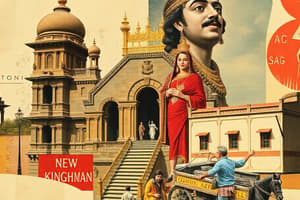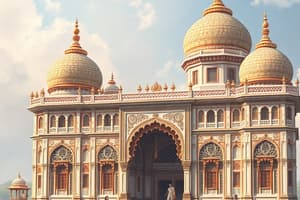Podcast
Questions and Answers
Which building is known as the 'whispering gallery' due to its unique acoustic properties?
Which building is known as the 'whispering gallery' due to its unique acoustic properties?
- Madarasas of Muhammad Gawan
- Golconda Fort
- Golgumbaz at Bijapur (correct)
- Juma Masjid at Gulbarga
Which language did the Bahmani Sultans primarily encourage for learning, along with Persian?
Which language did the Bahmani Sultans primarily encourage for learning, along with Persian?
- Sanskrit
- Arabic (correct)
- Urdu
- Hindi
Besides the construction of mosques, what other type of educational institution did the Bahmani Sultans patronize?
Besides the construction of mosques, what other type of educational institution did the Bahmani Sultans patronize?
- Stupas
- Monasteries
- Madarasas (correct)
- Temples
What was one of the major contributing factors to the decline of the Bahmani Kingdom, according to the provided text?
What was one of the major contributing factors to the decline of the Bahmani Kingdom, according to the provided text?
What was the direct influence on the Bhakti movement in medieval India, as per the provided text?
What was the direct influence on the Bhakti movement in medieval India, as per the provided text?
What was the primary function of the Mahanayakacharya within the empire's administration?
What was the primary function of the Mahanayakacharya within the empire's administration?
Which of these is NOT a characteristic of Sufism?
Which of these is NOT a characteristic of Sufism?
How was land revenue primarily determined during the empire's rule?
How was land revenue primarily determined during the empire's rule?
Who among these Sufi saints is known for settling in Ajmer and creating a center for his activities?
Who among these Sufi saints is known for settling in Ajmer and creating a center for his activities?
Which Sufi order was associated with Nizamuddin Auliya?
Which Sufi order was associated with Nizamuddin Auliya?
Besides judicial duties, what additional function did the king perform concerning the legal system?
Besides judicial duties, what additional function did the king perform concerning the legal system?
Which of the following best describes the position of women during the empire?
Which of the following best describes the position of women during the empire?
Which social practice did the society exhibit during the empire?
Which social practice did the society exhibit during the empire?
Which factor contributed most significantly to the empire's economic strength?
Which factor contributed most significantly to the empire's economic strength?
Which of the following languages was NOT prominently developed during the empire?
Which of the following languages was NOT prominently developed during the empire?
What was the major contributing factor to the decline of the empire?
What was the major contributing factor to the decline of the empire?
What was the primary function of the Diwan-I-Ariz during the Delhi Sultanate?
What was the primary function of the Diwan-I-Ariz during the Delhi Sultanate?
Which of the following best describes the structure of the empire at the provincial level?
Which of the following best describes the structure of the empire at the provincial level?
What role did the Panchayats play in the village administration?
What role did the Panchayats play in the village administration?
What was the main source of income for the Delhi Sultanate?
What was the main source of income for the Delhi Sultanate?
Who was the highest judicial authority during the Delhi Sultanate?
Who was the highest judicial authority during the Delhi Sultanate?
Which of the following describes a key feature of the Delhi Sultanate's army?
Which of the following describes a key feature of the Delhi Sultanate's army?
What were the main industries during the Delhi Sultanate period?
What were the main industries during the Delhi Sultanate period?
What was a significant feature of the Delhi Sultanate's architecture?
What was a significant feature of the Delhi Sultanate's architecture?
Flashcards
Sufism
Sufism
A style of Islamic mysticism that emphasizes love, devotion, and service to humanity as paths to God.
Shaikh Ismail of Lahore
Shaikh Ismail of Lahore
A famous Sufi saint who spread his ideas in Lahore and established the Chishti order.
Khwaja Muinuddin Chishti
Khwaja Muinuddin Chishti
A renowned Sufi saint known for his teachings in Ajmer, where he established the Chishti order.
Bahauddin Zakariya
Bahauddin Zakariya
Signup and view all the flashcards
Nizamuddin Auliya
Nizamuddin Auliya
Signup and view all the flashcards
Sufi Movement
Sufi Movement
Signup and view all the flashcards
Service to Humanity
Service to Humanity
Signup and view all the flashcards
Nizamuddin Auliya
Nizamuddin Auliya
Signup and view all the flashcards
Naik
Naik
Signup and view all the flashcards
Village Administration
Village Administration
Signup and view all the flashcards
Mahanayakacharya
Mahanayakacharya
Signup and view all the flashcards
Land Revenue
Land Revenue
Signup and view all the flashcards
Vijayanagara Army
Vijayanagara Army
Signup and view all the flashcards
Judicial Administration
Judicial Administration
Signup and view all the flashcards
Women's Position
Women's Position
Signup and view all the flashcards
Social Life
Social Life
Signup and view all the flashcards
Sultan
Sultan
Signup and view all the flashcards
Iqta
Iqta
Signup and view all the flashcards
Iqtadar
Iqtadar
Signup and view all the flashcards
Qazi-ul-quzar
Qazi-ul-quzar
Signup and view all the flashcards
Delhi Sultanate Architecture
Delhi Sultanate Architecture
Signup and view all the flashcards
Textile Industry
Textile Industry
Signup and view all the flashcards
Delhi or Imperial style
Delhi or Imperial style
Signup and view all the flashcards
Study Notes
No information provided. Please provide text or questions for a summary.
Studying That Suits You
Use AI to generate personalized quizzes and flashcards to suit your learning preferences.




